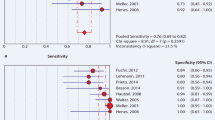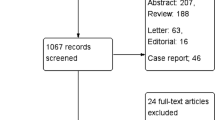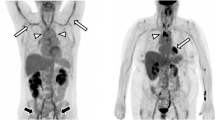Abstract
Purpose
We aimed to assess the impact of 18F-fluorodeoxyglucose (FDG) positron emission tomography (PET) on the management of patients with suspected large vessel vasculitis.
Methods
An international expert panel determined diagnoses and clinical management in patients with suspected large vessel vasculitis, with and without the results of 18F-FDG PET, respectively. The accuracy of the clinical diagnosis and the resulting clinical management with and without the 18F-FDG PET results were compared using logistic regression models.
Results
The analysis included 30 patients referred to a tertiary care centre with large vessel vasculitis and 31 controls. 18F-FDG PET had an overall sensitivity of 73.3% [95% confidence interval (CI) 54.1–87.7%], a specificity of 83.9% (95% CI 66.3–94.5%), a positive predictive value of 81.5% (95% CI 61.9–93.7%) and a negative predictive value of 76.5% (95% CI 58.8–89.3%). The diagnostic accuracy of 18F-FDG PET was higher in patients not receiving immunosuppressive drugs (93.3 vs 64.5%, p = 0.006). Taken in context with other available diagnostic modalities, the addition of 18F-FDG PET increased the clinical diagnostic accuracy from 54.1 to 70.5% (p = 0.04). The addition of 18F-FDG PET increased the number of indicated biopsies from 22 of 61 patients (36.1%) to 25 of 61 patients (41.0%) and changed the treatment recommendation in 8 of 30 patients (26.7%) not receiving immunosuppressive medication and in 7 of 31 patients (22.6%) receiving immunosuppressive medication.
Conclusion
18F-FDG PET is a sensitive and specific imaging tool for large vessel vasculitis, especially when performed in patients not receiving immunosuppressive drugs. It increases the overall diagnostic accuracy and has an impact on the clinical management in a significant proportion of patients.





Similar content being viewed by others
References
Salvarani C, Cantini F, Hunder GG. Polymyalgia rheumatica and giant-cell arteritis. Lancet 2008;372:234–45.
Basu N, Watts R, Bajema I, Baslund B, Bley T, Boers M, et al. EULAR points to consider in the development of classification and diagnostic criteria in systemic vasculitis. Ann Rheum Dis 2010;69:1744–50.
Mukhtyar C, Guillevin L, Cid MC, Dasgupta B, de Groot K, Gross W, et al. EULAR recommendations for the management of large vessel vasculitis. Ann Rheum Dis 2009;68:318–23.
Salvarani C, Silingardi M, Ghirarduzzi A, Lo Scocco G, Macchioni P, Bajocchi G, et al. Is duplex ultrasonography useful for the diagnosis of giant-cell arteritis? Ann Intern Med 2002;137:232–8.
Blockmans D. Utility of imaging studies in assessment of vascular inflammation. Cleve Clin J Med 2002;69 Suppl 2:SII95–9.
Tso E, Flamm SD, White RD, Schvartzman PR, Mascha E, Hoffman GS. Takayasu arteritis: utility and limitations of magnetic resonance imaging in diagnosis and treatment. Arthritis Rheum 2002;46:1634–42.
Kissin EY, Merkel PA. Diagnostic imaging in Takayasu arteritis. Curr Opin Rheumatol 2004;16:31–7.
Seo P, Stone JH. Large-vessel vasculitis. Arthritis Rheum 2004;51:128–39.
Aschwanden M, Kesten F, Stern M, Thalhammer C, Walker UA, Tyndall A, et al. Vascular involvement in patients with giant cell arteritis determined by duplex sonography of 2x11 arterial regions. Ann Rheum Dis 2010;69:1356–9.
Weber WA, Grosu AL, Czernin J. Technology insight: advances in molecular imaging and an appraisal of PET/CT scanning. Nat Clin Pract Oncol 2008;5:160–70.
Ishimori T, Saga T, Mamede M, Kobayashi H, Higashi T, Nakamoto Y, et al. Increased (18)F-FDG uptake in a model of inflammation: concanavalin A-mediated lymphocyte activation. J Nucl Med 2002;43:658–63.
Jones HA, Cadwallader KA, White JF, Uddin M, Peters AM, Chilvers ER. Dissociation between respiratory burst activity and deoxyglucose uptake in human neutrophil granulocytes: implications for interpretation of (18)F-FDG PET images. J Nucl Med 2002;43:652–7.
Turlakow A, Yeung HW, Pui J, Macapinlac H, Liebovitz E, Rusch V, et al. Fludeoxyglucose positron emission tomography in the diagnosis of giant cell arteritis. Arch Intern Med 2001;161:1003–7.
Brodmann M, Lipp RW, Aigner R, Pilger E. Positron emission tomography reveals extended thoracic and abdominal peri-aortitis. Vasc Med 2003;8:127–8.
Hara M, Goodman PC, Leder RA. FDG-PET finding in early-phase Takayasu arteritis. J Comput Assist Tomogr 1999;23:16–8.
Blockmans D, Maes A, Stroobants S, Nuyts J, Bormans G, Knockaert D, et al. New arguments for a vasculitic nature of polymyalgia rheumatica using positron emission tomography. Rheumatology (Oxford) 1999;38:444–7.
Meller J, Grabbe E, Becker W, Vosshenrich R. Value of F-18 FDG hybrid camera PET and MRI in early takayasu aortitis. Eur Radiol 2003;13:400–5.
Blockmans D, de Ceuninck L, Vanderschueren S, Knockaert D, Mortelmans L, Bobbaers H. Repetitive 18F-fluorodeoxyglucose positron emission tomography in giant cell arteritis: a prospective study of 35 patients. Arthritis Rheum 2006;55:131–7.
Meller J, Strutz F, Siefker U, Scheel A, Sahlmann CO, Lehmann K, et al. Early diagnosis and follow-up of aortitis with [(18)F]FDG PET and MRI. Eur J Nucl Med Mol Imaging 2003;30:730–6.
Walter MA, Melzer RA, Schindler C, Müller-Brand J, Tyndall A, Nitzsche EU. The value of [18F]FDG-PET in the diagnosis of large-vessel vasculitis and the assessment of activity and extent of disease. Eur J Nucl Med Mol Imaging 2005;32:674–81.
Webb M, Chambers A, AL-Nahhas A, Mason JC, Maudlin L, Rahman L, et al. The role of 18F-FDG PET in characterising disease activity in Takayasu arteritis. Eur J Nucl Med Mol Imaging 2004;31:627–34.
Blockmans D, Bley T, Schmidt W. Imaging for large-vessel vasculitis. Curr Opin Rheumatol 2009;21:19–28.
Henes JC, Müller M, Krieger J, Balletshofer B, Pfannenberg AC, Kanz L, et al. [18F] FDG-PET/CT as a new and sensitive imaging method for the diagnosis of large vessel vasculitis. Clin Exp Rheumatol 2008;26:S47–52.
Walter MA. [(18)F]fluorodeoxyglucose PET in large vessel vasculitis. Radiol Clin North Am 2007;45:735–44. viii.
Scheel AK, Meller J, Vosshenrich R, Kohlhoff E, Siefker U, Müller GA, et al. Diagnosis and follow up of aortitis in the elderly. Ann Rheum Dis 2004;63:1507–10.
Blockmans D, Coudyzer W, Vanderschueren S, Stroobants S, Loeckx D, Heye S, et al. Relationship between fluorodeoxyglucose uptake in the large vessels and late aortic diameter in giant cell arteritis. Rheumatology (Oxford) 2008;47:1179–84.
Spira D, Kötter I, Ernemann U, Balletshofer B, Pfannenberg CA, Fenchel M, et al. Imaging of primary and secondary inflammatory diseases involving large and medium-sized vessels and their potential mimics: a multitechnique approach. AJR Am J Roentgenol 2010;194:848–56.
Bleeker-Rovers CP, Bredie SJ, van der Meer JW, Corstens FH, Oyen WJ. Fluorine 18 fluorodeoxyglucose positron emission tomography in the diagnosis and follow-up of three patients with vasculitis. Am J Med 2004;116:50–3.
Iwabu M, Yamamoto Y, Dobashi H, Kameda T, Kittaka K, Nishiyama Y. F-18 FDG PET findings of Takayasu arteritis before and after immunosuppressive therapy. Clin Nucl Med 2008;33:872–3.
Miller MD, Ferris DG. Measurement of subjective phenomena in primary care research: the Visual Analogue Scale. Fam Pract Res J 1993;13:15–24.
Brodmann M, Lipp RW, Passath A, Seinost G, Pabst E, Pilger E. The role of 2-18F-fluoro-2-deoxy-D-glucose positron emission tomography in the diagnosis of giant cell arteritis of the temporal arteries. Rheumatology (Oxford) 2004;43:241–2.
Acknowledgements
The authors declare that they have no conflict of interest. Martin A. Walter gratefully acknowledges the support of the Swiss National Science Foundation. Matthias Briel and Heike Raatz are supported by santésuisse and the Gottfried and Julia Bangerter-Rhyner Foundation. Sergio Prieto-González and Maria C. Cid are supported by Ministerio de Ciencia e Innovacion (SAF 08/04328 and SAF 11/30073).
Author information
Authors and Affiliations
Corresponding author
Appendix
Appendix
The detailed expert scoring results are presented in Fig. 6.
Rights and permissions
About this article
Cite this article
Fuchs, M., Briel, M., Daikeler, T. et al. The impact of 18F-FDG PET on the management of patients with suspected large vessel vasculitis. Eur J Nucl Med Mol Imaging 39, 344–353 (2012). https://doi.org/10.1007/s00259-011-1967-x
Received:
Accepted:
Published:
Issue Date:
DOI: https://doi.org/10.1007/s00259-011-1967-x





